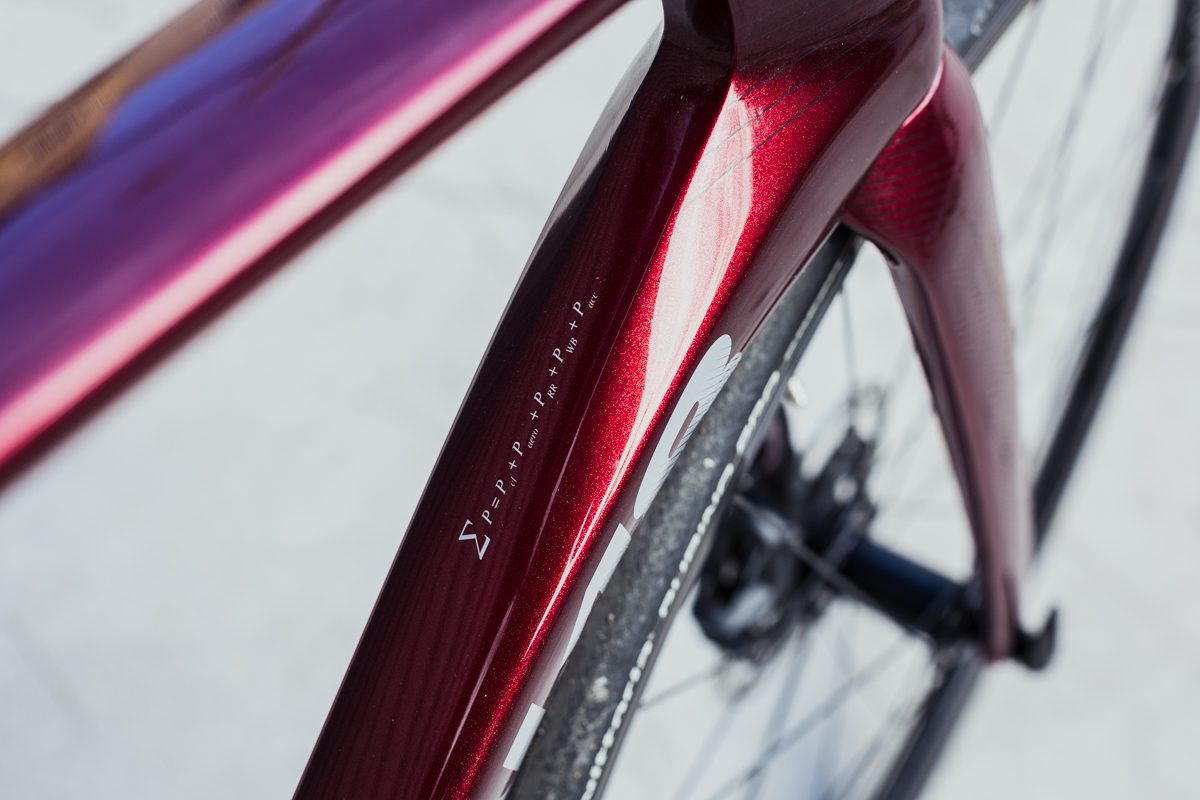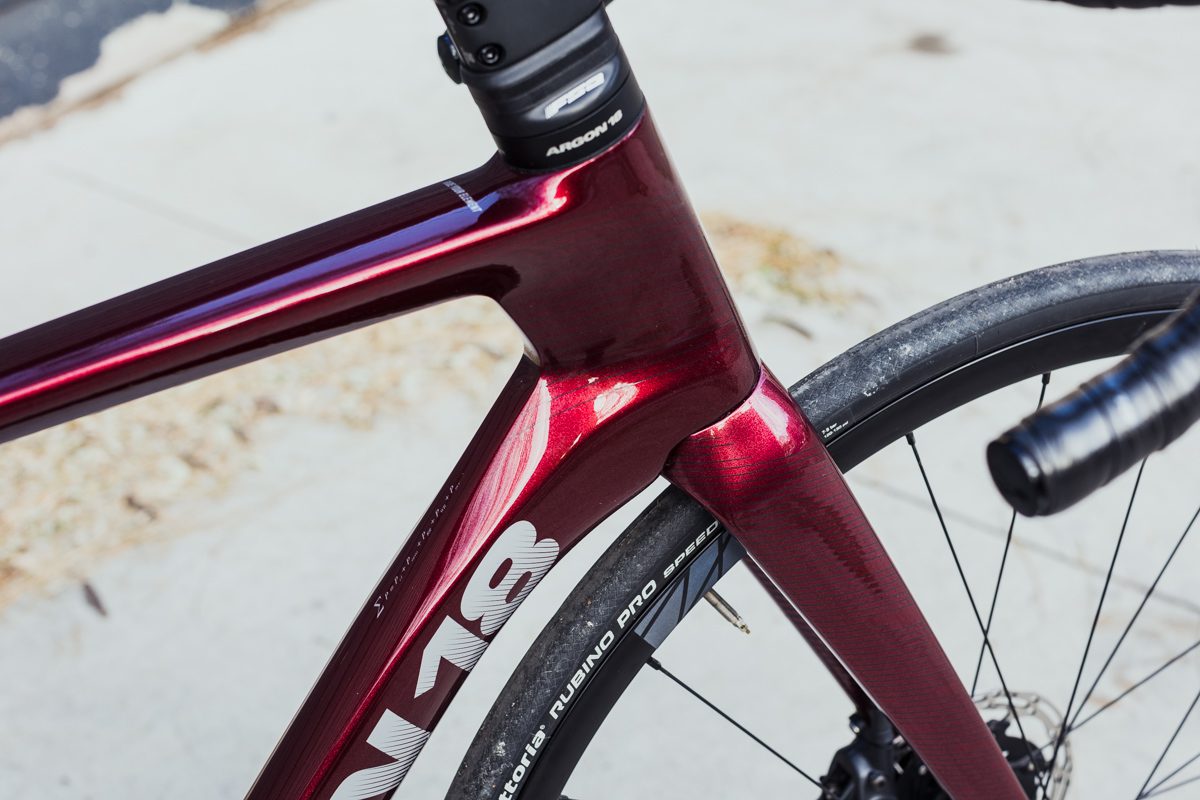Argon 18 Sum: First look and ride impressions of the new performance road bike
The Montreal company launches a new frame designed for hunting podiums
 Photo by:
Matt Stetson
Photo by:
Matt Stetson
The Argon 18 Sum is a new bike from the Montreal-based company. By new bike, I mean the name is new and the frame is new, even though it draws heavily from various designs and technologies that Argon 18 has used on previous models. With the addition of the Sum, Argon 18 is subtracting other models from its lineup. A look at the outgoing models tells you what the Sum is all about.
So long Gallium and Nitrogen
The Gallium has been in the company’s lineup since 2005. It’s served as the all-around road racing bike with a focus on keeping the frame’s weight low. The Nitrogen, which debuted in 2014, is Argon 18’s aero road bike with tubes shaped to cut through the wind as efficiently as possible. You won’t see new versions of these bikes in 2022. (Argon is keeping the Gallium CS Disc, the more entry-level frame.)
“We’re doing away with platforms that are successful. For some people, they’ll perceive this as a bold move,” said Alain Pelletier, vice-president of marketing. “But that shows we’re at a point where we can come up with the Sum and be confident that it is now the better bike.”
In 2020, Specialized did something similar. When the U.S. company put out its latest Tarmac with its improved aerodynamics, the Venge—the aero road model—was discontinued. While Giant and Trek’s launches of the past two years didn’t lead to cuts in their lineups, the TCR and Émonda both followed the trend of the “aero-fication” of climber’s bikes.

In a video call this past November, with the new Sum hanging above my desk waiting for the next test ride, I asked Pelletier and his colleague Jonathan Beaulieu, vice-president of product, why now was the right time for Argon 18 to come out with the Sum? What had made that frame and the changes to the company’s lineup possible?
Getting better with carbon fibre
First, Beaulieu took a step back, way back it seems, to the transition from aluminum to carbon fibre as the main material for the company’s frames. At first, carbon tubes mimicked aluminum ones. “We were doing black aluminum,” Beaulieu said. “Then, at some point, we realized we could make different shapes. What kind of opportunities could that bring us? Well, we could make tubes more aero. We could play with the properties of the bike. Sections of the down tube, going down to the bottom bracket, could be more rigid, increasing power transfer. We kept on evolving sections of the bike.
“We’ve really focused on understanding and mastering carbon-fibre composite. It’s one of our strengths. In Montreal, we do have aeronautics around, so we do have people who know their way around that. Why not bank on that? We don’t manufacture this bike, but we are still in control when it comes to understanding and making the bike behave the way we want it to behave.”
Pelletier added that aero bikes used to be heavier than all-around bikes. They simply couldn’t help it. Aero tubes needed more material, which increased the weight. With more R and D into tube shapes, and the rise of the truncated-airfoil design, weight decreased.
“The mix has long been aero against weight, but not now,” Beaulieu said. “The development team knows how to make the sections more aero, but also how to tailor the mix between rigidity and vertical compliance for comfort. We can mix up the variables for the perfect recipe.”
Adding up the different parts of the Argon 18 Sum

The designers of the Sum took elements from other bikes in the Argon 18 stable. For the fork, they looked to the design of the Electron track bike: its fork blades direct the air outward, away from the down tube and rider’s legs. The Sum’s low seatstays come partly out of the development of the company’s time trial and triathlon bikes, such as the E-119. Yet, those stays aren’t all about aerodynamics. They add some comfort, too. The seatstays are curved in such a way that they bow outward and flex in that direction when the bike hits rough surfaces. That feature migrated to the Sum from the endurance-focused Krypton Pro.
The cutout in the lower part of the seat tube is traditionally used for aero gains. The outgoing Nitrogen had a pretty deep tube and cutout. The new Sum’s is narrower. It helps with airflow, but also adds some compliance to mellow the ride.
The Sum’s head tube has an hourglass shape, which is aero and helps to keep the frame stiff and light.

Any minuses to the Argon Sum?
One of Argon’s lightest frames was the rim-brake (remember that?!) Gallium Pro. It weighed 759 g. When that bike got disc brakes, it also gained some grams. It was 840 g. The Sum Pro, the top-end Sum frame, weighs 850 g in size medium. Are the extra grams on the new bike worth it? Argon 18 says they are.
The company ran a simulation comparing the Gallium Pro and the Sum Pro. They took a rider putting out the same amount of power on each bike throughout the Stage 6 route of the 2019 Tour de France, featuring La Planche des Belles Filles. The Sum Pro was faster by 75 seconds according to Argon 18’s calculations. “Aero wins over weight in this case,” Beaulieu said.

A range of sizes for the right fit on the Argon 18 Sum
With the Sum range of frames, from XXS to XL, the company has made adjustments in geometry to accommodate a wider range of riders, especially those on frames smaller than a medium. Beaulieu said quite a few companies will design a medium frame and then will have the factory scale the design for the other sizes. That approach can often result in the large and/or the small frames behaving differently, usually not as well as the original medium. Beaulieu stressed that Argon 18 works on the characteristics of each frame size of the Sum. Compared with the Gallium, the size small has less reach and more stack. That trend continues down the line. Pelletier summed up with, “The progression is smoother between models. It’s tweaking the geometry so it’s a better fit in the smaller sizes.”
The large and XL frames have their own fork, while size medium and smaller use a fork that is tuned for them.
Bars, stem and another dimension
Like the Nitrogen, the Sum has its hoses hidden. The FSA bars and FSA ACR stem send the brake lines (no shifting cables as the 2022 Sums are all wireless) into the head tube unseen. The nice thing about the ACR stem is that it lets you run other, albeit compatible, handlebars. It’s more flexible than some integrated setups that only give you one bar/stem option.
Argon 18 specs its 3D technology to give you more fit options. This system offers head-tube extensions that let you raise the position of the stem while maintaining stiffness for precise steering. These extensions are much sturdier than a tall stack of spacers. The 3D system on the Sum is new. It’s been modified to work with the internal-cable routing.

Differences between the Argon 18 Sum Pro and Sum
The Sum Pro is the top-end frame, while the Sum is a little heavier with a different carbon-fibre layup. All the tube shapes are the same between the two models. A medium size Sum Pro is 850 g. The Sum of the same size is 890 g. The Pro uses a lighter, stiffer fork than the regular Sum.
What’s next from Argon 18
Whenever a company comes out with something new, I always try to find out what’s next. They are, after all, already working on the next new thing. The answers I get are usually some variation of “you’ll have to wait until we’re ready to share the next new thing.” To Beaulieu and Pelletier’s credit, they did give me just a little bit more than that standard answer. Beaulieu said they can keep looking for the perfect combination of aerodynamics and low weight. The move to disc brakes brought more weight to frames that they are working to shed while still keeping frames safe and strong. “Integrated disc brakes could be something as well,” he said. It’s an area that Argon 18 has explored in the past.
Canadian prices for 2022 Argon 18 Sum models
| Model | Spec | Canadian Price |
|---|---|---|
| Sum Pro | SRAM Force eTap AXS | $10,500 |
| Sum Pro | SRAM Rival eTap AXS | $8,350 |
| Sum | SRAM Force eTap AXS | $7,350 |
| Sum | SRAM Rival eTap AXS | $6,250 |
| Sum Pro | frameset | $5,999 |
Argon 18 Sum first impressions
My test bike was the Argon 18 Sum with a SRAM Force drivetrain. It rolled on Hunt 4 Season All-Road wheels. It weighs 7.79 kg. That’s pretty svelt for the company’s second-level frame. Still, for it to really compete on climbs, I think it could still shed a few grams. In 2021, I rode Argon 18’s Gallium, also a second-tier frame, with the new Shimano Dura-Ace. That build was around 800 g lighter, a weight that I think is achievable with the Sum.
Grams aside, the bike handles great. I do like its behaviour in the corners. The Sum also has plenty of pedalling stiffness for hard efforts on the flat and going up. For sure, this is a capable racer. On my long rides, the vibration damping properties of the seatstays and seat tube seemed to do their thing as I didn’t feel taxed by the bumps. Despite the few extra grams, the Sum’s speed and comfort really do have Argon’s old frames beat. All the changes on the new bike seem to add up.

